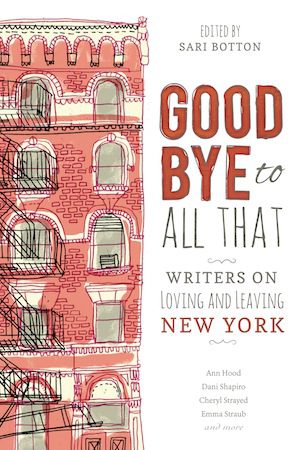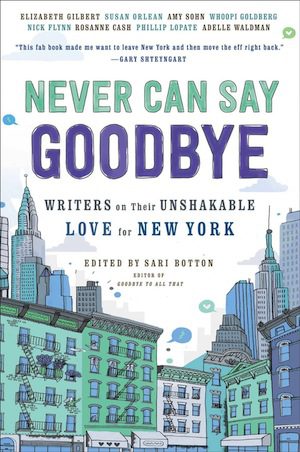Last fall, a small press published an anthology titled Goodbye to All That: Writers on Loving and Leaving New York. This fall, an imprint of Simon and Schuster published a follow-up essay collection by the same editor: Never Can Say Goodbye: Writers on Their Unshakeable Love for New York. The fact that this publishing trend jumped from a small press to a big one suggests that the business of rethinking the axes of cultural sway in the US has gained a foothold in the New York publishing world. Add to this trend that Flavorwire piece about how “the middle of the country (not Brooklyn) is the future of American literature” and the fact that Lena Dunham’s character from Girls is moving to Iowa City next January, and it’s safe to say that talk about leaving New York isn’t going anywhere.
But such talk is probably just a ploy to get rent prices down in Brooklyn. New York will never not be the center of American literature. The sooner we citizens of Elsewhere understand that, the better. Something else we need to understand sooner rather than later is that it’s good to <3 NYC. It’s a cultural failing not to, an indicator of how deeply the red/blue logic of twenty-first-century electoral maps has bled into the fabric of American life.
As Joan Didion asserts through the title of her much-imitated essay, “Goodbye to All That” (1967), New York is “all that,” the shining somewhere of late empire. We need to love it, and from the safe distance of not having to pay its rent.
We all know that the rent in New York is too damn high. As Sari Botton cites in her introduction to Never Can Say Goodbye, median rent in the city is up 75% since 2000. David Bryne argues in his searing op-ed that the 1% is killing creative culture in New York. That’s part of the terrible truth that the Zuccotti Park protests dramatized but that no human microphone could change: more than it is the capital of American literature, New York is the capital of FIRE (finance, insurance, and real estate). It has been for decades, which is why writers should go to New York the way Muslims go to Mecca. Make pilgrimages. Pay homage, not rent.
Pretty much every recent trend piece about leaving New York includes something about being priced out. From Carrie Luna’s Salon essay: “Over the years, as I’ve gone back to visit, the sting of betrayal, of having been priced out of what I thought of as my birthright … has lessened.” Eventually the pain of not being able to live in New York fades enough that, if you’re Luna, you can start to enjoy raising chickens in Portland. But the feeling that New York is the one that got away never fades.
 The Goodbye to All That anthology (GTAT) includes a number of variations on the idea that New York is every writer’s birthright. For some, the birthright is a license to first-world decadence. Meghan Daum assures us that the upside of being an irresponsible waste of space in the most crowded, important city on the planet is that “the thing you’ll look back on for the rest of your life is New York.” New York is where you go to have the experiences that will become the memories that will help you endure the boredom of suburban adulthood.
The Goodbye to All That anthology (GTAT) includes a number of variations on the idea that New York is every writer’s birthright. For some, the birthright is a license to first-world decadence. Meghan Daum assures us that the upside of being an irresponsible waste of space in the most crowded, important city on the planet is that “the thing you’ll look back on for the rest of your life is New York.” New York is where you go to have the experiences that will become the memories that will help you endure the boredom of suburban adulthood.
But the decadent refrain of “go, be young in New York and fail beautifully” may be getting replaced by accounts that set the privilege of couch surfing into vivid relief. Roxane Gay’s contribution to the GTAT anthology debunks the idea that New York is a first-world playground. The daughter of Haitian immigrants who lived in the Bronx in the 1970s, Gay doesn’t consider New York a birthright so much as an unsightly birthmark. While most of the rest of the contributors to the GTAT anthology write as though they are one winning lottery ticket away from moving back, Gay is happy to live elsewhere.
Similarly, Eula Biss’s GTAT essay (not included in the GTAT anthology but in her much lauded essay collection, Notes from No Man’s Land) assures us that, while Didion’s claim that New York is “a city only for the very young” is true, the stories that those young people tell are nostalgia-lacquered nuggets invented to give an air of consequence to what was probably an entirely narcissistic decision. After reading Botton’s anthology, it’s refreshing to read sentences like this one, from Biss: “I learned to make my experience of being young and new to the city sound effortless and zany. It was not.” And this one: “I never stopped thinking about leaving.” And especially this one:
When someone who spends the better part of everyday in a cubicle and only occasionally makes it out to sit in a loud, dull bar tells me that she is living in the city of “the pace, the excitement, the culture, the—you know—stimulation,” I have trouble fully believing her.
It may be cathartic to see the NYC humblebrag get skewered.
In twenty-first-century fiction, the city is back to being a Gotham—the living ground of a magical America that’s on the brink of losing it all. It’s the site of superstorms (Ben Lerner’s 10:04), zombie apocalypses (Colson Whitehead’s Zone One), and nostalgia for the 1970s—that era when artists ran wild in Manhattan (Rachel Kushner’s The Flamethrowers), homeless men taught children how to fly (Jonathan Lethem’s Fortress of Solitude), and Frenchmen tightroped across the World Trade Center towers (Colum McCann’s Let the Great World Spin). In such a context, Biss’s focus on the quotidian seems fussy—it also suggests that creative nonfiction may be picking up the legacy of realism that literary fiction is starting to slough off.
Botton’s pro-New York follow-up to the GTAT anthology, Never Can Say Goodbye, is interesting in such a context. Like recent novels about New York, the collection keeps Gotham superheroic. There are a lot of celebrity contributors, from non-writers (Rosanne Cash and Whoopi Goldberg) to capital-W writers (Elizabeth Gilbert and Susan Orlean). Along with such famous people are the founders and editors of such playful revivers of literary culture as Flavorwire and The Rumpus. There’s some of the annoying Columbusing that you’d expect to find in an “I <3 NYC” collection (“I found a little luncheonette on Nassau Avenue that looked as if the interior and prices hadn’t been updated since around 1979”). And there’s some snark, as in Phillip Lopate’s essay, which has this to say about the GTAT trend: “I find such essays …tedious and beside the point. They came here for a party and overstayed. Poor dears. They viewed it in their twenties as a Mecca for the young and then got older; tsk! tsk!”
 But most of the essays are shameless expressions of the subtitle’s Unshakable Love. Contributors Jason Diamond and Colin Harrison both admit to being “collectors,” by which they mean hoarders, of things they love about New York. According to Diamond, “New Yorkers are all collectors, often of things that we don’t necessarily want or really need… we all collect something; it’s part of how you hold on to your sanity in this fast-paced city—by holding on.” Harrison’s apartment is covered in thousands of maps of the city:
But most of the essays are shameless expressions of the subtitle’s Unshakable Love. Contributors Jason Diamond and Colin Harrison both admit to being “collectors,” by which they mean hoarders, of things they love about New York. According to Diamond, “New Yorkers are all collectors, often of things that we don’t necessarily want or really need… we all collect something; it’s part of how you hold on to your sanity in this fast-paced city—by holding on.” Harrison’s apartment is covered in thousands of maps of the city:
I gather them, I stack them, I devour them. I want them .… I desire and need and require maps of New York City, I crave them, I fever for them, I feel that a map I do not have but want is rightfully mine; I must touch them and smell them and possess them, must run my finger along their stiff or soft or irregular damaged edges.
Harrison’s fetishism doesn’t let up. The essay ends with the writer jumping down into a nineteenth-century map of Manhattan, down through chimney smoke and right into the dress of a Manhattan lady (May Welland, perhaps). Even Lopate gets a little kinky, musing that the “milk I drank from my mother’s breast probably contained window soot or was diluted with traces of Rheingold beer and egg creams” and confessing that his favorite thing to do in the city is creep on young subway readers. And there’s this: “The Brooklyn Bridge is my mother, the Empire State Building my father. The ichor of my blood is from the Gowanus Canal, the lymph that flows in my veins is Hudson River-drawn”.
Having grown up in the Midwest wishing I were in New York, such fetishizing rings familiar to me. The inner life into which I retreated as kid was made of people walking around and talking to each other on city sidewalks, à la Annie Hall (1977), and living in possibly-possessed high-rise apartments, à la Ghostbusters (1984). The pull was strong, and it felt real (though it was made out of movies).
As I got older, especially as I started to teach and write about American literature as a faculty member at a Midwestern university, I dismantled my New York paracosm. It felt irresponsible, downright negligent, to be encouraging young writers to generate wonderful, enchanting narratives out of lives lived in American elsewheres while knowing all the while that I would give it up tomorrow to be even a minor character in New York—a Rick Moranis living down the hall from a Sigourney Weaver.
But, thanks in part to Never Can Say Goodbye, I am ready to stop worrying and love the city, even if it’s a wholly invented city. To continue to resist the urge to love New York from an American elsewhere is to ensure that red/blue stagnation itself will get worse.





4 responses
Is this just a ploy to use Didion’s name? Much more recently, she left California and was very critical of the entire state, and was living in . . . . NEW YORK CITY. I left San Francisco in 1970, but I don’t put it down. Be careful, the place you speak of so disparagingly today, may seem like heaven tomorrow.
“most crowded, important city on the planet”, if you truly believe that in late 2014, I think you better wake up Snow White to join you for a flight on Smaug in Wonderland. Or better still, book a trip to China or even India. NY is a great city and will remain so, but nostalgia can be blinding. Take your lover (in this case NYC) down off the pedestal and look her/him in the eye. You may love reality, warts and all, far more than the dream.
I just had to chuckle reading David Byrne complaining about rent prices in N.Y.C.! I priced the electrical work for the gut renovation of his townhouse circa 1989-90,(located just off lower 5th Ave.—right near Malcolm Forbes’ place, which I also worked on) to make it into his office/studio/music space. I disagree with Meghan Dunham. My years from 1978 t0 1992 will be One of the things I’ll look back on, not The thing. That kind of thought seems poverty driven in terms of life experience. Roxanne Gay’s comment fits right in with her hectoring, culture of victimhood writing….really, “an unsightly birthmark”? Manhattan is one of the few cities in the U.S. where one day you’ll see Phillip Glass riding the 14th street bus in the middle of the afternoon, chat him up for a minute, and the next week on that same 14th street, get a gun put in your side by a crackhead at a Chinese take out. This planet is a huge crazy place and N.Y.C. is just part of it.
Writers that came/come to New York aren’t “New Yorkers.” Killing somebody on the streets of Besonhurst, that’s a New Yorker.
Click here to subscribe today and leave your comment.